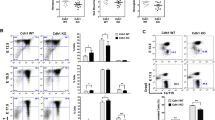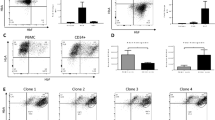Abstract
ERYTHROLEUKAEMIC mouse spleen cells (Friend cells) can undergo erythropoietic differentiation in vitro when cultured in the presence of a variety of different inducers1–6. Untreated Friend cells are arrested at a proerythroblast-like stage of development in the erythropoietic lineage7 and contain little or no globin mRNAs and no haemoglobin. In response to an inducer the cells start transcribing the globin genes, accumulate globin mRNAs and haemoglobin in the cytoplasm3,8 and express morphological and biochemical changes which parallel changes observed during normal in vivo erythropoiesis in the mouse. Dimethyl sulphoxide-induced Friend cells (strain 745 A) show a transient block in the initiation of DNA synthesis which precedes detectable expressions of the differentiated functions9. We report here a G1 phase prolongation in another Friend cell line using another inducer (n-butyrate). We have also characterised the induction process in respect of the capacity of the cells to synthesise and transport proteins to the nucleus. The rate of synthesis of total nuclear proteins decreases steadily but the histones show a reproducible pattern of an initial increase in this parameter at a time when DNA synthesis is blocked, indicating that histone synthesis becomes independent of DNA replication during Friend cell differentiation.
Similar content being viewed by others
References
Friend, C., Scher, W., Holland, J. G. & Sato, T. Proc. natn. Acad. Sci. U.S.A. 68, 378–382 (1971).
Ostertag, W., Melderis, H., Steinheider, G., Kluge, N. & Dube, S. Nature new Biol. 239, 231–234 (1972).
Ross, J., Ikawa, Y. & Leder, P. Proc. natn. Acad. Sci. U.S.A. 69, 3620–3623 (1972).
Reuben, R. C., Wife, R. L., Brestow, R., Rifkind, R. A. & Marks, P. A. Proc. natn. Acad. Sci. U.S.A. 73, 862–866 (1976).
Gusella, J. F. & Housman, D. Cell 8, 263–269 (1976).
Leder, A. & Leder, P. Cell 5, 319–322 (1975).
Harrison, P. R. Nature 262, 353–356 (1976).
Pragnell, I. B., Ostertag, W. & Paul, J. Expl Cell Res. 108, 269–279 (1977).
Terada, M., Fried, J., Nudel, U., Rifkind, R. A. & Marks, P. A. Proc. natn. Acad. Sci. U.S.A. 74, 248–252 (1977).
Swetly, P. & Ostertag, W. Nature 252, 642–644 (1974).
Adolf, G. R. & Swetly, P. Biochim. biophys. Acta 518, 334–344 (1978).
Rastl, E. & Swetly, P. J. biol. Chem. 253, 4333–4340 (1978).
Robbins, E. & Borun, T. Proc. natn. Acad. Sci. U.S.A. 57, 409–416 (1967).
Terada, M. Proc. natn. Acad. Sci. U.S.A. 75, 2795–2799 (1978).
Laemmli, U. K. Nature 227, 680–685 (1970).
Riggs, M. G., Whittaker, R. G., Neumann, J. R. & Ingram, V. M. Nature 268, 462–464 (1976).
Candido, E. P. M., Reeves, R. & Davie, J. R. Cell 14, 105–113 (1978).
Zlatanova, J. & Swetly, P. Cell (submitted).
Orkin, S. H., Haroshi, F. I. & Leder, P. Proc. natn. Acad. Sci. U.S.A. 72, 98–102 (1975).
Author information
Authors and Affiliations
Rights and permissions
About this article
Cite this article
ZLATANOVA, J., SWETLY, P. Uncoupled synthesis of histones and DNA during Friend cell differentiation. Nature 276, 276–277 (1978). https://doi.org/10.1038/276276a0
Received:
Accepted:
Issue Date:
DOI: https://doi.org/10.1038/276276a0
- Springer Nature Limited
This article is cited by
-
Dissociation between cellular DNA- and histone synthesis following infection by cytomegalovirus in the presence of phosphonoacetic acid
Archives of Virology (1981)
-
Lack of coupling between DNA and histone synthesis in growth-arrested Friend erythroleukemia cells
Molecular and Cellular Biochemistry (1981)
-
Histone exchange in chromatin of hydroxyurea-blocked Ehrlich ascites tumour cells
Nature (1980)
-
DNA and histone synthesis in mouse cells which exhibit temperature-sensitive DNA synthesis
Somatic Cell Genetics (1980)
-
Histones and DNA increase synchronously in neurons during early postnatal development of the rat forebrain cortex
Histochemistry (1979)





